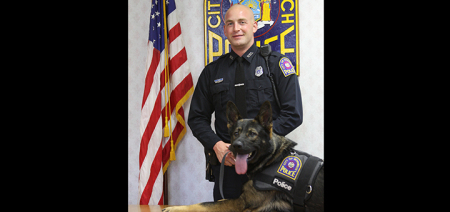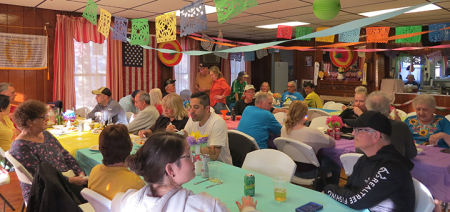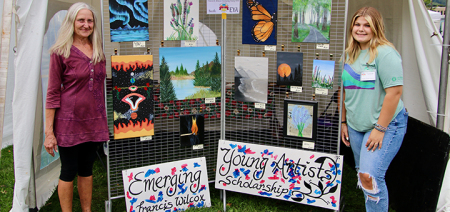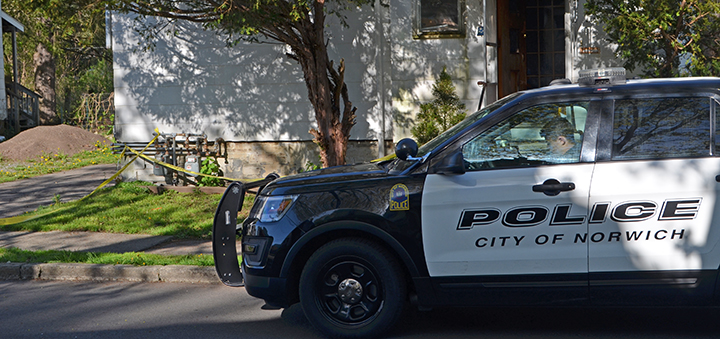When Visitors Arrive – Tips For Keeping Your Excited Pup Calm
Published:
April 27th, 2023
By:
Sarah Genter
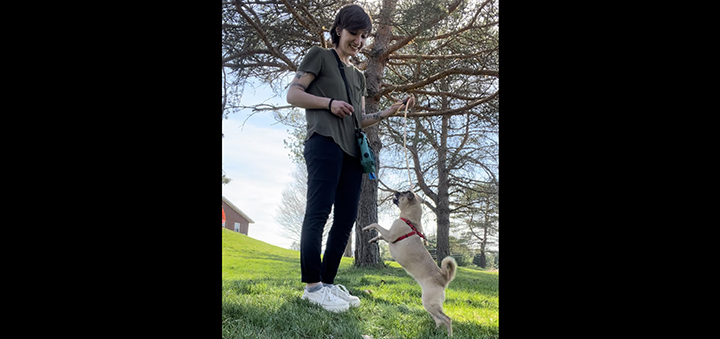 It can be difficult to greet visitors when you have an excited dog in the mix running to the door and jumping on guests, but there are ways to teach your dog to stop jumping and sit patiently while you answer the door. (Photo by Sarah Genter)
It can be difficult to greet visitors when you have an excited dog in the mix running to the door and jumping on guests, but there are ways to teach your dog to stop jumping and sit patiently while you answer the door. (Photo by Sarah Genter)
This past weekend, I had the pleasure of meeting a few readers and their adorable cavachon named JoJo. They contacted me for some advice on keeping their little guy calm when visitors arrive at home.
JoJo is an extremely friendly pup who greets visitors by sprinting to the front door and jumping up on people as they come in. Fortunately, as a Cavalier King Charles spaniel and bichon frise mix, he’s pretty small – it’s not like being jumped on by something like a husky or a mastiff!
However, it can still make it harder to greet people and invite them into your home when there’s an excited dog in the mix, no matter the size.
But, there are methods out there that can help! My favorite involves teaching your dog impulse control by having them sit patiently while you let your visitor in, then giving your dog the all clear to go up and say hi.
The key here is consistency – If you’re using a particular method, whether this one or another, to curb your dog’s barking or jumping, you must employ that method every single time someone comes to your door.
Dogs don’t understand “sometimes,” meaning they don’t understand that when one specific person comes over they’re allowed to jump, but they’re not allowed to jump on anyone else. Either they can jump up on everyone or no one. A lack of consistency in allowable behavior will only confuse them and make it that much harder to curb the unwanted behavior.
Teaching “stay”
Start off by teaching your dog the “stay” cue. Have them sit, then hold your hand up with your palm facing them and tell them to stay. Back up one step, then take one step back to them. If they stay sitting, great! You can give them a treat reward. If they don’t, just try again. It may take a few attempts before they understand what they have to do to get the treat.
Once your dog stays in place for one step back, do the same thing again, but this time take two steps back, then two steps forward. If they stay, give them a treat and move on to taking three steps back, then four, and so on, until your dog is staying in place long enough that you would be able to answer the door and greet your visitors.
If at any point your dog moves from where you told them to stay, start again with only one step back. This method helps to reinforce the behavior and build up the amount of time your dog is able to sit still.
Once your dog understands “stay” and is performing the cue consistently, you can move on to the next step: a practice visit!
Practice visits
Have a patient household member or friend come to your front door to knock or ring the doorbell. When your dog sprints to the door, first move them several feet away from the door by using body blocking.
To use body blocking, step between your dog and the door, moving into their personal space and being careful not to step on their toes! Your dog should naturally back up a step or two. Continue to step toward them, causing them to step back, until they are a few feet away from the door.
Once they’re away from the door, tell them to sit and stay, and go to open the door. If your dog moves toward the door, use body blocking again to back them up and tell them to sit and stay again.
You might find that your dog stays until you begin to actually open the door, and then they run forward to say hi. If this happens, close the door and move them away again. This teaches them that they don’t get what they want until they perform the desired behavior – in this case, sitting calmly until given permission to greet.
Eventually you’ll be able to open up the door and let your visitor in while your dog stays where you told them to. After your visitor gets inside and you shut the door, you can then tell your dog to “say hi,” or something similar, to let them know they can now approach and greet your guest.
Tips for success
JoJo was a bit of an anomaly in that after the first run through of a practice visit, he knew exactly what to do. In fact, the second time he didn’t even go to the door! Cavachons are very smart and eager to please, so it’s no surprise he picked up on what to do so quickly.
However, it’s more likely it will take some practice before your dog stays calm and seated as you answer the door. Stay patient, and remember that training is supposed to be fun for both you and your dog!
You should also make sure to factor in breaks when training. If your dog is still a puppy, their attention spans will be shorter. Training sessions should only be about 10 to 15 minutes at a time, with breaks for playtime in between.
You can also prevent distraction during training sessions by making sure your dog has gone to the bathroom beforehand, and that they’ve eaten recently. However, don’t feed your dog a meal right before training. You’ll need treats to reinforce the correct behavior, so you don’t want them to be full, but you also don’t want them to be distracted because they’re starving!
Most importantly, stay consistent! You must do this every single time someone comes to your door, no matter who it is. If you still let your dog run and jump on some of your visitors, you’re only sabotaging the hard work you and your dog have put into training.
How your visitors can help
If you’re expecting guests, be sure to let them know ahead of time that you’re working on training your dog to sit patiently away from the door, and that it may take you a minute or two to let them in.
Of course, the idea is to retry opening the door until your dog sits and waits for the all clear to say hello. But after that point, your dog might still get excited and jump on your guests!
If you have a mailbox or some other closed container outside near your front door, you might also consider stashing a small treat pouch in there. When you’re expecting visitors, tell them when they arrive to grab the treats before coming to the door.
Then, when they come inside, if your dog starts jumping up on them, instruct your guest to toss a treat to the floor a couple feet away. This will give your dog something else to focus on, and give them a little extra time to calm down.
Another method is to have your guest turn their back to the dog every time they jump up. Because your dog is happy to see them and is seeking attention and interaction, turning away and ignoring them when they jump teaches them that they only get attention when all four paws are on the floor.
While these are my favorite methods for teaching a dog to stay calm when visitors stop by, they’re certainly not the only ones out there! Plus, every dog is different, and may have different motivators or learning styles that make this method less effective.
Look around for other training methods that may fit your dog better if you find this technique isn’t working for you. Just make sure to only employ training methods that are force-free and cause no physical or mental harm to your dog – it will make training more fun and effective, and strengthen the bond between you and your pooch.
Do you have any questions about dog training, dog behavior, or dog breeds? Send me an email at sgenter@evesun.com to have your question answered in a future column! Please keep in mind that as I’m still earning my certification, I may wait to answer some questions until I have the proper knowledge and training needed to provide a thorough and accurate answer.
Author: Sarah Genter - More From This Author
Comments

